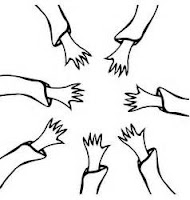My student complained of feeling "stretchy" in measures eleven and thirty-three. He also felt "slippery" on the black keys, which is not good when playing in seven sharps.
A show of hands please: Is it ever acceptable to feel stretched? That's right. The answer is never. Remember, the hand can be open, flexible, without opening to an extreme, extreme being the operative word. The solution to this student's problem lies in re-thinking the fingering as follows:
 |
| Bach Fugue in C-Sharp Major, Book One MM 11 and 53. |
Trying to balance the fingers along the razor's edge in what is essentially a black key study can be challenging. Again, the solution is simple. Angle the right hand slightly to the right in order to provide more finger flesh to the key. This will feel more secure. Don't try a perpendicular approach to the keys.





